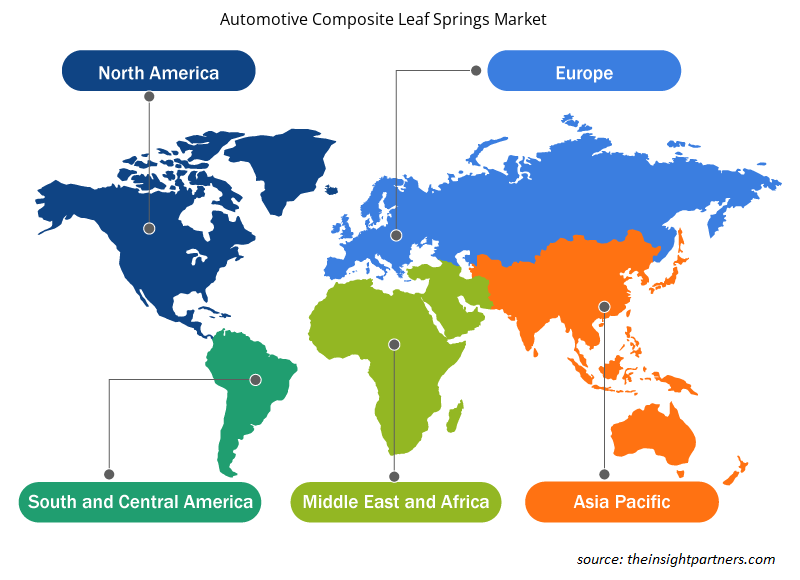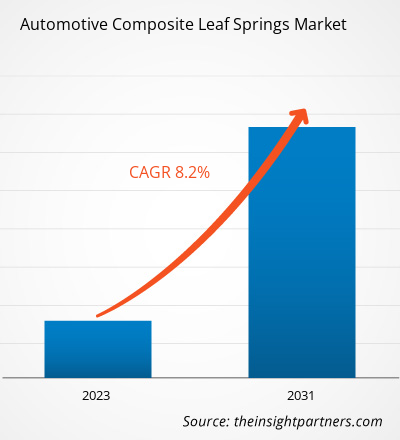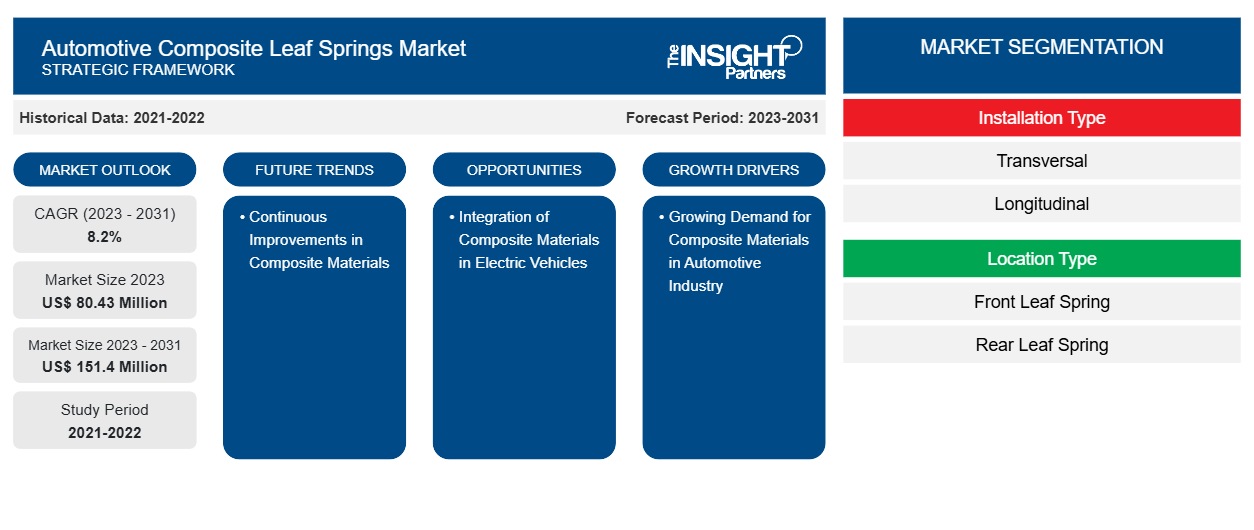Der Markt für Verbundblattfedern für Kraftfahrzeuge soll von 80,43 Millionen US-Dollar im Jahr 2023 auf 151,4 Millionen US-Dollar im Jahr 2031 anwachsen. Der Markt wird zwischen 2023 und 2031 voraussichtlich eine durchschnittliche jährliche Wachstumsrate (CAGR) von 8,2 % verzeichnen. Die kontinuierliche Verbesserung von Verbundwerkstoffen dürfte ein wichtiger Trend auf dem Markt bleiben.
Marktanalyse für Blattfedern aus Verbundwerkstoff für Kraftfahrzeuge
Die steigende Nachfrage nach Verbundwerkstoffen bei der Herstellung von Komponenten im Automobilsektor dürfte das Marktwachstum im analysierten Zeitraum ankurbeln. Darüber hinaus wird erwartet, dass der weltweit steigende Absatz von Nutzfahrzeugen und Personenkraftwagen wie SUVs und leichten Nutzfahrzeugen das Wachstum des Marktes für Verbundblattfedern für Kraftfahrzeuge im analysierten Zeitraum ankurbeln wird. Darüber hinaus dürfte die Integration und zunehmende Verwendung von Verbundwerkstoffen in Elektrofahrzeugen von 2023 bis 2031 Chancen für die Unternehmen schaffen, die auf dem Markt für Verbundblattfedern für Kraftfahrzeuge tätig sind.
Marktübersicht für Verbundblattfedern für Kraftfahrzeuge
Das Ökosystem des Marktes für Verbundblattfedern für Kraftfahrzeuge besteht aus den folgenden Interessengruppen: Rohstofflieferanten, Hersteller von Verbundblattfedern, OEMs und Endverbraucher. Die Rohstofflieferanten liefern das Verbundmaterial, wie etwa Polymermatrix-Verbundwerkstoffe, kohlenstofffaserverstärkte Kunststoffe und Epoxidharz-basierte Verbundwerkstoffe, die zur Herstellung der Verbundblattfedern für Kraftfahrzeuge erforderlich sind. Die Expansion der Automobilindustrie hat dazu geführt, dass verschiedene Verbundwerkstofflieferanten, wie etwa TPI Composites, mit Automobilherstellern und Automobilkomponentenherstellern zusammenarbeiten. Die Hersteller von Verbundblattfedern für Kraftfahrzeuge sind an verschiedenen Prozessen beteiligt, wie etwa Design, Montage und Produktion, um das Rohverbundmaterial in fertige Produkte umzuwandeln. Muhr und Bender KG, KraussMaffei und SGL Carbon sind einige der führenden Hersteller von Verbundblattfedern für Kraftfahrzeuge. Diese Unternehmen bieten OEMs wie BMW, Daimler, Volvo und Ford Motor Company hochwertige Verbundblattfedern an, die das Produkt schließlich während der Fahrzeugproduktion einbauen. Die Endverbraucher sind eine große Anzahl von Kunden, von Privatwagenkäufern bis hin zu großen Flottenbetreibern.
Passen Sie diesen Bericht Ihren Anforderungen an
Sie erhalten kostenlose Anpassungen an jedem Bericht, einschließlich Teilen dieses Berichts oder einer Analyse auf Länderebene, eines Excel-Datenpakets sowie tolle Angebote und Rabatte für Start-ups und Universitäten.
-
Holen Sie sich die wichtigsten Markttrends aus diesem Bericht.Dieses KOSTENLOSE Beispiel umfasst eine Datenanalyse von Markttrends bis hin zu Schätzungen und Prognosen.
Markttreiber und Chancen für Blattfedern aus Verbundwerkstoff für Kraftfahrzeuge
Steigende Nachfrage nach Verbundwerkstoffen im Automobilsektor begünstigt den Markt
Die Vorteile von Verbundblattfedern gegenüber herkömmlichen Blattfedern treiben ihre Verbreitung in der Automobilindustrie voran. Sie sind etwa 70 % leichter als Stahlfedern, dünner und kompakter sowie langlebig und belastungsbeständig. Darüber hinaus ermöglichen sie eine größere Flexibilität beim Design und verfügen über hervorragende Fahreigenschaften. Verbundblattfedern bieten auch eine verbesserte Stoßdämpferleistung in Fahrzeugen , was ihre Verbreitung bei Fahrzeugherstellern fördert, die sich auf effektive Lastausgleichslösungen konzentrieren. So hat Hexcel beispielsweise fortschrittliche Blattfedern auf Verbundbasis entwickelt, die Pickup-Trucks dabei helfen, ihre Ladung effektiv zu handhaben. Die neuen Verbundblattfedern des Unternehmens tragen dazu bei, das Gesamtgewicht von Pickup-Trucks um etwa 20 Kilogramm pro Fahrzeug zu reduzieren. Der zunehmende Fokus auf die Verwendung von leichten Verbundwerkstoffen in Automobilanwendungen dürfte das Marktwachstum im Prognosezeitraum vorantreiben. Darüber hinaus wird erwartet, dass ein verstärkter Fokus auf die Verbesserung der Leistung und Effizienz von Fahrzeugen durch Minimierung des Gewichts das Marktwachstum von 2023 bis 2031 ankurbeln wird.
Integration von Verbundwerkstoffen in Elektrofahrzeuge
Elektrofahrzeuge stellen einen neuen Trend in der Automobilindustrie dar, da Verbraucher und Regierungen in verschiedenen Anwendungen stark zum Verbrauch von Ökostrom tendieren. Elektrofahrzeuge machen einen geringeren Anteil am gesamten Fahrzeugmarkt aus, verzeichnen jedoch eine höhere Wachstumsrate als kraftstoffbetriebene Fahrzeuge. Hersteller von Elektrofahrzeugen verwenden Verbundwerkstoffe, um das Fahrzeuggewicht als Batterien zu reduzieren. Dies hilft ihnen, das zusätzliche Gewicht der Batterien, die mit der Zeit sperriger werden, auszugleichen, um die Reichweite des Fahrzeugs zu erhöhen. Aura, ein neuer vollelektrischer zweisitziger Konzeptsportwagen, der im September 2021 vorgestellt wurde, wurde unter Verwendung von Naturfaserverbundwerkstoffen entwickelt, die dazu beitragen, das Fahrzeuggewicht zu reduzieren und die Herstellungsprozesse nachhaltiger zu gestalten. Darüber hinaus veröffentlichte eine Gruppe von Forschern in Indien eine Studie über Verbundblattfedern für Elektrofahrzeuge zur Reduzierung von Lärm, Vibrationen und Rauheit. Demnach zeichnen sich die Verbundblattfedern durch ein 40 % geringeres Gewicht, eine 76,39 % geringere Spannungskonzentration und eine 50 % geringere Verformung als gestufte Stahlblattfedern aus.
Segmentierungsanalyse des Marktberichts für Blattfedern aus Verbundwerkstoff für Kraftfahrzeuge
Wichtige Segmente, die zur Ableitung der Marktanalyse für Verbundblattfedern für Kraftfahrzeuge beigetragen haben, sind Installationstyp, Standorttyp, Prozesstyp und Fahrzeugtyp
- Basierend auf der Installationsart ist der Markt für Verbundblattfedern für Kraftfahrzeuge in Quer- und Längsfedern unterteilt. Das Quersegment hatte im Jahr 2023 den größten Marktanteil.
- Nach Standorttyp ist der Markt in vordere Blattfedern und hintere Blattfedern segmentiert. Das Segment der hinteren Blattfedern hatte im Jahr 2023 den größten Marktanteil.
- In Bezug auf den Prozesstyp ist der Markt in Hochdruck-Harztransferformverfahren, Prepreg-Layup-Verfahren und andere unterteilt. Die Segmente des Hochdruck-Harztransferformverfahrens hielten im Jahr 2023 einen erheblichen Marktanteil.
- Nach Fahrzeugtyp ist der Markt in Personenkraftwagen, leichte Nutzfahrzeuge sowie mittelschwere und schwere Fahrzeuge segmentiert. Das Pkw-Segment hatte im Jahr 2023 den größten Marktanteil.
Marktanteilsanalyse für Blattfedern aus Verbundwerkstoff für Kraftfahrzeuge nach geografischen Gesichtspunkten
Der geografische Umfang des Marktberichts für Verbundblattfedern für Kraftfahrzeuge ist hauptsächlich in fünf Regionen unterteilt: Nordamerika, Asien-Pazifik, Europa, Naher Osten und Afrika sowie Süd- und Mittelamerika.
Der Umfang des Marktberichts für Verbundblattfedern für Kraftfahrzeuge umfasst Nordamerika (USA, Kanada und Mexiko), Europa (Deutschland, Frankreich, Italien, Spanien, Großbritannien und den Rest von Europa), den asiatisch-pazifischen Raum (China, Indien, Australien, Japan, Südkorea und den Rest des asiatisch-pazifischen Raums), den Nahen Osten und Afrika (Südafrika, Saudi-Arabien, Vereinigte Arabische Emirate und den Rest des Nahen Ostens und Afrikas) sowie Südamerika (Brasilien, Argentinien und den Rest von Südamerika). In Bezug auf den Umsatz dominierte Europa im Jahr 2023 den Marktanteil von Verbundblattfedern für Kraftfahrzeuge. Der asiatisch-pazifische Raum war der zweitgrößte Umsatzträger zum globalen Markt für Verbundblattfedern für Kraftfahrzeuge, gefolgt von Nordamerika.
Regionale Einblicke in den Markt für Verbundblattfedern für Kraftfahrzeuge
Die regionalen Trends und Faktoren, die den Markt für Verbundblattfedern für Kraftfahrzeuge im gesamten Prognosezeitraum beeinflussen, wurden von den Analysten von Insight Partners ausführlich erläutert. In diesem Abschnitt werden auch die Marktsegmente und die Geografie von Verbundblattfedern für Kraftfahrzeuge in Nordamerika, Europa, im asiatisch-pazifischen Raum, im Nahen Osten und Afrika sowie in Süd- und Mittelamerika erörtert.

- Erhalten Sie regionale Daten zum Markt für Verbundblattfedern für Kraftfahrzeuge
Umfang des Marktberichts zu Verbundblattfedern für Kraftfahrzeuge
| Berichtsattribut | Details |
|---|---|
| Marktgröße im Jahr 2023 | 80,43 Millionen US-Dollar |
| Marktgröße bis 2031 | 151,4 Millionen US-Dollar |
| Globale CAGR (2023 - 2031) | 8,2 % |
| Historische Daten | 2021-2022 |
| Prognosezeitraum | 2023–2031 |
| Abgedeckte Segmente |
Nach Installationstyp
|
| Abgedeckte Regionen und Länder |
Nordamerika
|
| Marktführer und wichtige Unternehmensprofile |
|
Marktteilnehmerdichte für Blattfedern aus Verbundwerkstoff für Kraftfahrzeuge: Auswirkungen auf die Geschäftsdynamik verstehen
Der Markt für Verbundblattfedern für Kraftfahrzeuge wächst rasant. Dies wird durch die steigende Nachfrage der Endverbraucher aufgrund von Faktoren wie sich entwickelnden Verbraucherpräferenzen, technologischen Fortschritten und einem größeren Bewusstsein für die Vorteile des Produkts vorangetrieben. Mit der steigenden Nachfrage erweitern Unternehmen ihr Angebot, entwickeln Innovationen, um die Bedürfnisse der Verbraucher zu erfüllen, und nutzen neue Trends, was das Marktwachstum weiter ankurbelt.
Die Marktteilnehmerdichte bezieht sich auf die Verteilung der Firmen oder Unternehmen, die in einem bestimmten Markt oder einer bestimmten Branche tätig sind. Sie gibt an, wie viele Wettbewerber (Marktteilnehmer) in einem bestimmten Marktraum im Verhältnis zu seiner Größe oder seinem gesamten Marktwert präsent sind.
Die wichtigsten auf dem Markt für Verbundblattfedern für Kraftfahrzeuge tätigen Unternehmen sind:
- Hendrickson Holding LLC
- Flex-Form
- KraussMaffei
- Muhr und Bender KG
- Olgun Celik AS
- SGL Carbon SE
Haftungsausschluss : Die oben aufgeführten Unternehmen sind nicht in einer bestimmten Reihenfolge aufgeführt.

- Überblick über die wichtigsten Akteure auf dem Markt für Verbundblattfedern für Kraftfahrzeuge
Neuigkeiten und aktuelle Entwicklungen zum Markt für Verbundblattfedern für Kraftfahrzeuge
Der Markt für Verbundblattfedern für Kraftfahrzeuge wird durch die Erhebung qualitativer und quantitativer Daten nach Primär- und Sekundärforschung bewertet, die wichtige Unternehmensveröffentlichungen, Verbandsdaten und Datenbanken umfasst. Nachfolgend sind einige der Entwicklungen auf dem Markt für Verbundblattfedern für Kraftfahrzeuge aufgeführt:
- Bcomp (Sustainable Lightweight Company) hat den Einsatz der Naturfaser-Verbundtechnologie namens ampliTex im neuen Volvo EX30 angekündigt. (Quelle: Bcomp, Pressemitteilung, Juni 2023)
- Hexion, Inc. ist eine Partnerschaft mit Rassini eingegangen. Ziel dieser Partnerschaft ist die Verwendung des Epoxidharzsystems EPIKOTE für Verbundblattfedern im neuen Ford F-150-Modell. (Quelle: Hexion, Inc., Pressemitteilung, Juni 2021)
Marktbericht zu Blattfedern aus Verbundwerkstoff für Kraftfahrzeuge – Umfang und Ergebnisse
Der Bericht „Marktgröße und Prognose für Verbundblattfedern für Kraftfahrzeuge (2021–2031)“ bietet eine detaillierte Analyse des Marktes, die die folgenden Bereiche abdeckt:
- Marktgröße und Prognose für Verbundblattfedern für Kraftfahrzeuge auf globaler, regionaler und Länderebene für alle wichtigen Marktsegmente, die im Rahmen des Berichts abgedeckt sind
- Markttrends für Verbundblattfedern für Kraftfahrzeuge sowie Marktdynamik wie Treiber, Einschränkungen und wichtige Chancen
- Detaillierte PEST- und SWOT-Analyse
- Marktanalyse für Verbundblattfedern für Kraftfahrzeuge mit Blick auf wichtige Markttrends, globale und regionale Rahmenbedingungen, wichtige Akteure, Vorschriften und aktuelle Marktentwicklungen
- Branchenlandschaft und Wettbewerbsanalyse mit Marktkonzentration, Heatmap-Analyse, prominenten Akteuren und aktuellen Entwicklungen auf dem Markt für Verbundblattfedern für Kraftfahrzeuge
- Detaillierte Firmenprofile
- Historische Analyse (2 Jahre), Basisjahr, Prognose (7 Jahre) mit CAGR
- PEST- und SWOT-Analyse
- Marktgröße Wert/Volumen – Global, Regional, Land
- Branchen- und Wettbewerbslandschaft
- Excel-Datensatz
Aktuelle Berichte
Verwandte Berichte
Erfahrungsberichte
Grund zum Kauf
- Fundierte Entscheidungsfindung
- Marktdynamik verstehen
- Wettbewerbsanalyse
- Kundeneinblicke
- Marktprognosen
- Risikominimierung
- Strategische Planung
- Investitionsbegründung
- Identifizierung neuer Märkte
- Verbesserung von Marketingstrategien
- Steigerung der Betriebseffizienz
- Anpassung an regulatorische Trends























 Kostenlose Probe anfordern für - Markt für Verbundblattfedern für die Automobilindustrie
Kostenlose Probe anfordern für - Markt für Verbundblattfedern für die Automobilindustrie